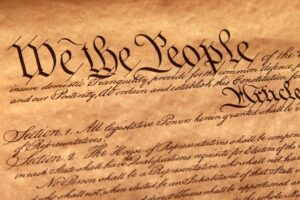 It’s not every day a conservative attorney general in a deep red state issues such a stinging rebuke of a scheme to fund religious education. After all, supporting religious education is a universal conservative policy preference to further school “choice” outside of traditional secular public schools. However, when an Oklahoma school board approved the establishment of a public religious charter school, Gentner Drummond, the Oklahoma AG, had nothing to offer but condemnation.
It’s not every day a conservative attorney general in a deep red state issues such a stinging rebuke of a scheme to fund religious education. After all, supporting religious education is a universal conservative policy preference to further school “choice” outside of traditional secular public schools. However, when an Oklahoma school board approved the establishment of a public religious charter school, Gentner Drummond, the Oklahoma AG, had nothing to offer but condemnation.
“The approval of any publicly funded religious school is contrary to Oklahoma law and not in the best interest of taxpayers,” Drummond said. “It’s extremely disappointing that board members violated their oath in order to fund religious schools with our tax dollars. In doing so, these members have exposed themselves and the State to potential legal action that could be costly.”
In many ways the harsh criticism by the Oklahoma AG is warranted. Oklahoma’s school board has taken an unprecedented step that differs from every other state, including from every other conservative state. To be sure, other states can and recently must now be forced to fund religious private schools (more on that below). But in every other state the funding is directed by individual citizens, and that third-party attenuation from state control has mattered a great deal. Indeed, the Supreme Court has been clear for a long time now that direct funding of religious education violates the plain text of our federal constitution prohibiting religious establishments.

Pursuing The Pro Bono Story: A Conversation With Alicia Aiken
This Pro Bono Week, get inspired to give back with PLI’s Pursuing Justice: The Pro Bono Files, a one-of-a-kind podcast hosted by Alicia Aiken.
But in another far more important way, none of that matters in the slightest. What is the value of hundreds of years of precedent or unambiguously clear constitutional language compared to the personal preferences of six religious conservative justices currently on the United States Supreme Court? The answer is: nothing. This majority has already radically transformed religious liberty in a way that completely ignores original public meaning of constitutional text and obliterates centuries of relevant constitutional theory. What Oklahoma has done is merely taken the next logical step on the path these religious conservative justices have been forcing the country down in recent years.
To Briefly Explain How We Got Here
For over two and a half centuries, a bedrock tenet of federal religious liberty was a recognition that religion is constitutionally distinct. What is meant by distinct? The first 10 words of the First Amendment make the distinction obvious: “Congress shall make no law respecting an establishment of religion.” The immediate thing to notice about these words is the nonestablishment prohibition is extended only to one area of our culture, religion. In other words, neither Congress nor the states are prohibited from creating laws, including those that involve forcible taxation, respecting establishments of literally any other aspect of our culture. Congress and the states can and do respect establishments of science, only “respecting an establishment of religion” is prohibited.
Why did the founders single out religion for such distinction? The answer is for damn good reason. As James Madison explained at the time:

Stand With Survivors: Legal Tools To Make A Real Difference This DVAM
Enhance your legal skills to advocate for survivors of intimate partner violence.
During almost fifteen centuries has the legal establishment of Christianity been on trial. What have been its fruits? More or less in all places, pride and indolence in the Clergy, ignorance and servility in the laity, in both, superstition, bigotry and persecution.
When the federal establishment clause was incorporated to the states in the middle of the 20th century, the recognition of religion as constitutionally distinct continued into the modern era. Although the Court in Everson upheld secular bus reimbursements to religious schools in a 5-4 split, both the majority and the vigorous dissent were at least in full agreement that state support of religious education violated the establishment clause. For the next 80 years, from Everson to Locke v. Davey, the court maintained that government can be prohibited from directly supporting religious education because of the distinct nature religion holds in both our constitution and our history.
But in just five short years and in a mere three cases (Trinity Lutheran, Espinoza, and Makin), the new Trump-nominated justice era dismantled the entire concept of religious distinction within education and replaced it with a selective doctrine of nondiscrimination. In each of these cases, state statutes that excluded all religious entities from indirect government funding based on religious status were struck down. According to the new religious conservative majority such categorical exclusion based on religious status amounted to impermissible discrimination.
You may be forgiven if a doctrine of nondiscrimination against religion doesn’t sound all that bad to you at first. But the moment you apply an ounce of scrutiny to this new sea change in religious liberty, the abandoning of religious distinctiveness and replacing it with a norm of nondiscrimination is revealed as a disaster of legal contradiction and gross hypocrisy. I think the inherent problem of it all has been stated best by Professors Ira Lupu and Robert Tuttle in their excellent work, “The Remains of the Establishment Clause“:
The change [from distinctiveness to nondiscrimination] creates an irreconcilable conflict with respect to the most basic principles of the Establishment Clause. The Establishment Clause requires distinctive treatment of religion; a norm of nondiscrimination forbids distinctive treatment of religion. These principles cannot co-exist.
See the rub? If religion cannot be treated as distinct then much of what we value about religious liberty becomes impermissible discrimination. Including RFRA laws that conservatives so often cherish. Indeed, how can any religious exemption from general applicable law ever be squared under a doctrine of nondiscrimination? Whatever one thinks about religious exemption generally, whether it is constitutional or should be broadly applied, categorically exempting entities or individuals from often costly general applicable law is not a system of neutrality. It’s a system where government is excluding certain groups from burdensome laws that carry harsh penalties based on nothing more than their religious status or lack thereof.
The Ministerial Exception
Take for example the “ministerial exception.” This is an exception from general applicable law upheld by the new religious conservative majority at the same time it was insisting on neutrality in funding schemes, indeed in the same term! Except the “ministerial exception” is anything but neutral. It is a doctrine that insists upon the exclusion of religious organizations and only religious organizations from costly, burdensome statutory labor laws/regulations based on nothing more than, wait for it, religious status!
Viewed through the lens of nondiscrimination, the “ministerial exception” wrongly appears sinister and unfair to every nonreligious entity that must abide by costly and potentially ruinous labor laws. The only way the ministerial exception makes sense, is if you view the situation through the lens of religious distinctiveness. Religious employees, namely clergy, are distinct from all other employees precisely because of their religious character. All the ministerial exception is doing is maintaining the distinct nature religion holds in our constitution as an essential element of liberty. The problem is one cannot reasonably reconcile why the government cannot treat religion as distinct when it comes to government benefits but must treat religious organizations as distinct whenever treating them the same presents the slightest burden. There is only one consistent principle emerging from this new religious conservative majority’s jurisprudence, and it is certainly not neutrality.
In applying the ministerial exception, the religious conservative majority is doing exactly what it says government cannot: differentiate or “discriminate” against entities based on their religious status in a way that is beneficial to one type and exclusionary to the other. When nonreligious organizations and individuals are left to abide by expensive and ruinous regulation suddenly categorical exclusion from a benefit based on religious status no longer matters to the six religious conservative justices.
Back To Oklahoma
All of which brings us back to Oklahoma. Upholding any limit on direct support of religious education while leaving Oklahoma free to directly support equivalent nonreligious entities fits the very definition of categorical “discrimination” under this court’s new doctrine. Therefore, for the court to strike down what Oklahoma is doing would create only more chaos and inconsistency within the doctrine. A much more likely outcome, and one already being offered by religious conservative commentators like David French, is where the majority declares limits on direct funding of religious education as acceptable. Meanwhile, statutorily expanding establishment clause liberty over third-party attenuated, indirect funding schemes remain impermissible.
But that likely result only begs the question of what constitutional text or original meaning justifies such limits on establishment clause liberty while states and the federal government are free to statutorily expand free exercise liberty over the desires of third-party decision making? The two clauses are literally in the same sentence and are supposed to complement one another. A religious conservative majority creating such wildly different standards for each clause in a way that just so happens to favor religious conservatives in both respects strains credulity. This is not neutrality. What’s needed is a return to an even-handed approach based on a fundamental recognition of the distinction religion holds in our constitution.
As a final note, I would encourage everyone reading this to read the whole article by Lupu and Tuttle. I would also encourage everyone to read what I consider to be the best counterargument written by Professor Douglas Laycock: “Churches, Playgrounds, Government Dollars—and Schools?” Laycock, in my humble opinion, is this country’s best legal religious scholar. But being the best doesn’t mean one is perfect, and I think Laycock is simply wrong when it comes to the issue of a nondiscrimination doctrine (or his broad application of the “most favored nation” theory) for reasons I hope to have articulated here.
The author is a practicing attorney and religious liberty scholar who wishes to remain anonymous.